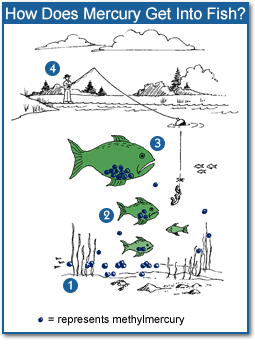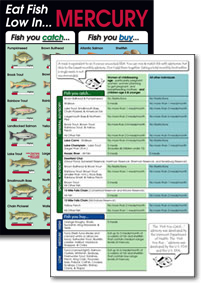Human Exposure to Mercury Due to Fish Consumption
The card on the left shows the relative levels of mercury found in fish you catch in the waters of Vermont and fish you buy at your local grocer.
While fish consumption is the main source of exposure to methylmercury, the Vermont Department of Health advises that the benefits and risks of eating fish should be balanced, since fish are an excellent source of high-quality protein and omega-3 fatty acids, and are low in saturated fat. In order to protect Vermonters from mercury poisoning, the Health Department issues fish consumption advisories which recommend limits for consumption of fish caught in Vermont waters. These recommendations are based on an assessment of the health risks posed by mercury or PCB (polychlorinated biphenyls) levels detected in fish, tests of hundreds of fish caught in Vermont waters in the past 10+ years, and scientific information about the harmful effects of mercury and PCBs. There are specific advisories for pregnant women, for young children (under the age of 6) and for the rest of the population. The advisories vary according to fish species and body of water. The Vermont Departments of Health, Fish & Wildlife and Environmental Conservation have developed a 6" x 9.25" downloadable fish advisory card that includes Vermont Department of Health and U.S. Food and Drug Administration fish consumption advisories. Although the Vermont Department of Health does not issue advisories on “Fish you buy” such as salmon, cod, pollock, sole, shrimp, mussels, and scallops, these species generally have lower mercury levels and are therefore considered safe for consumption. Other commercially available fish such as shark, swordfish, and fresh or frozen tuna generally have higher mercury concentrations.
Learn more with the FDA advice regarding eating fish (2018).
Bioaccumulation of Mercury
Once in a lake or river, mercury is converted to methylmercury by bacteria and other processes. Fish absorb methylmercury from their food and from water as it passes over their gills. Mercury is tightly bound to proteins in all fish tissue, including muscle. There is no method of cooking or cleaning fish that will reduce the amount of mercury in a meal.

Methylmercury accumulates as you move up the food chain:
- Methylmercury in the water and sediment is taken up by tiny animals and plants known as plankton.
- Small fishes eat large quantities of plankton over time.
- Large predatory fish consume many smaller fish, accumulating methylmercury in their tissues. The older and larger the fish, the greater the potential for high mercury levels in their bodies.
- Fish are caught and eaten by humans and animals, causing methylmercury to accumulate in their tissues.
The State of Vermont Fish Contaminant Monitoring Program has been monitoring the levels of mercury in fish tissue since 1987. Measurable concentrations have been observed in 95% of the samples collected from lakes and rivers across the state.
Methylmercury in Fish
Methylmercury is held tightly to fish protein when absorbed through the gills or when contaminated food sources are eaten. In some cases, methylmercury levels in carnivorous fish, such as freshwater bass, walleye and pike, and marine shark and swordfish, bioaccumulates up to a million times greater than in the surrounding water. In general, levels of mercury increase with fish size and age, although not always. Levels also vary by species and location.
Methylmercury
In the environment, particularly lakes, waterways and wetlands, mercury can be converted to a highly toxic, organic compound called methylmercury through biogeochemical interactions. Methylmercury, which is absorbed into the body about six times more easily than inorganic mercury, can migrate through cells which normally form a barrier to toxins. It can cross the blood-brain and placental barriers, allowing it to react directly with brain and fetal cells. Mercury contamination causes a wide range of symptoms in organisms, and affects the kidneys and neurological systems in particular. While low levels may not be directly lethal for individual organisms, toxicological effects like impaired reproduction, growth, neuro-development, and learning ability, in addition to behavioral changes, can lead to increases in mortality and the risk of predation for some wildlife.
Human Exposure to Mercury Due to Fish Consumption
Mercury emissions from natural and anthropogenic sources enter the global mercury cycle and are distributed in the environment locally and globally through various processes. Atmospheric emissions of mercury can enter the environment through deposition onto soils and water. When mercury enters fresh water bodies and the oceans, or settles into sediments and soils, it can become involved in biogeochemical cycles, be transformed into the highly toxic form of methylmercury, and bioaccumulate in the food chain. Predatory, freshwater fish species such as pike, bass and walleye have also been known to attain elevated methylmercury that may be almost completely absorbed by human or animal consumers.
Other Human Exposure Pathways to Mercury
Inhalation - Based on available science, normal ambient air concentrations of mercury vapour, averaging 1.6 nanograms per cubic meter of air, do not appear to be a cause for concern (1 nanogram = one billionth of a gram).
Dermal Contact - Dermal contact is also a route of exposure to mercury with alkyl mercury compounds being particularly notorious. While few Vermonters come into direct contact with mercury or its compounds, skin absorption can be lethal. In 1997, a researcher named Karen Wetterhahn, from Dartmouth College in New Hampshire, died when a single drop of dimethylmercury passed through her protective latex glove and through her skin.
What happens if I am exposed to mercury?
When an individual is exposed to mercury, a certain percentage is absorbed, depending on the route of exposure and the form of the mercury. About 80% of elemental mercury is absorbed when inhaled, however less than 1% of ingested liquid mercury is absorbed. Methylmercury, on the other hand, is readily absorbed irrespective of the exposure pathway. Approximately 95% of ingested methylmercury is absorbed, and absorption through the lungs and skin is also believed to be quite high. Both elemental and methylmercury can cross the blood-brain and placental barriers. The critical target organ for elemental mercury is the adult and fetal brain, and the critical target organs for methylmercury are the brain and the kidneys.
Inorganic mercury compounds do not readily migrate through the blood-brain or placental barriers, but do accumulate in the kidneys. Absorption of inorganic mercury varies with the type of inorganic salt. Within the body, the kidneys accumulate the highest concentrations of all forms of mercury, yet mercury can also concentrate in the brain, the central nervous system, the liver, and indeed in most organs in the body.
Mercury is predominantly excreted from the body in urine and feces, but usually at a slower rate than that of uptake, leading to the accumulation of mercury in living tissue. Mercury is deposited in hair as it grows, and it may also be found in breast milk. This may result in high concentrations in infants whose mothers are heavily exposed. The unborn child also receives some of the maternal mercury body burden because mercury compounds cross the placental barrier, yielding equal or higher blood concentrations in the fetus than in the mother.

